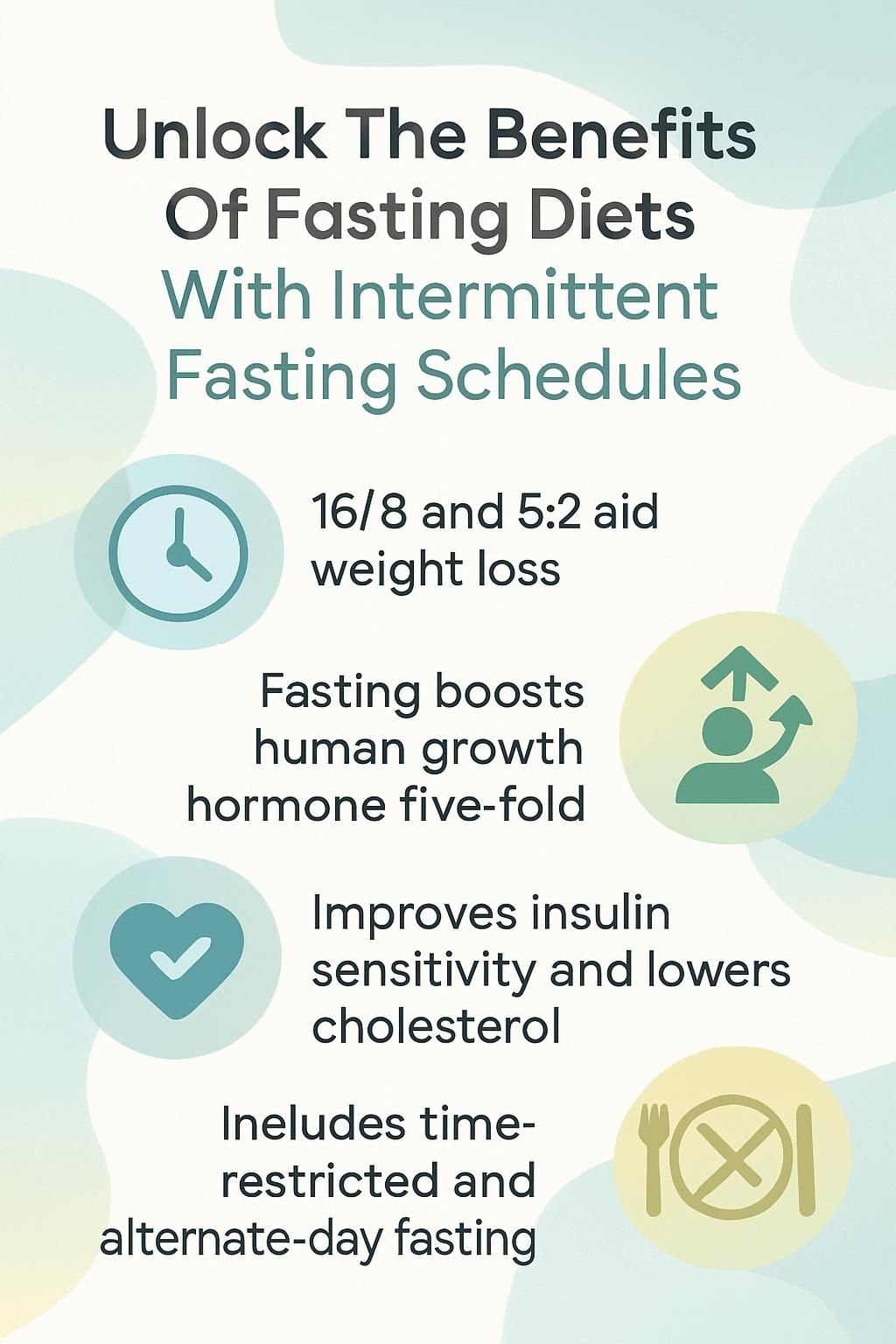Unlock The Benefits Of Fasting Diets With Intermittent Fasting Schedules
Our Nutrition Assistant AI Suite will transform your body. You will lose fat, get toned, and build muscle. Gain confidence and optimal health.
You might feel worn out by strict diet rules, confusing meal plans, or stubborn weight. Intermittent fasting shifts the focus from what you eat to when you eat. That simple change can support steady weight management and better health.
In this guide, you will explore common intermittent fasting schedules, the effects of intermittent fasting on your body, and practical tips to make a fasting diet work in real life. Small adjustments to your eating pattern can add up to big wins for energy, mood, and confidence.
Key Takeaways
- Time-restricted plans such as 16/8 and the 5:2 approach can reduce body weight. A 2020 review reported average losses ranging from 0.8% to 13% in adults.
- Evidence links intermittent fasting with better insulin sensitivity, lower blood sugar, and improved cholesterol, which supports heart health (Varady KA et al., Nutrition Reviews, 2021).
- Studies show periods of fasting can raise human growth hormone, support autophagy, the cell cleanup process, and reduce certain inflammation markers.
- Popular options include time-restricted eating, alternate-day fasting, and one or two full-day fasts each week.
- People under 18, those who are pregnant, anyone using insulin for type 1 diabetes, or people with a history of eating disorders should only try intermittent fasting with medical supervision.

What Is Intermittent Fasting?

Intermittent fasting is an eating plan that cycles between eating and fasting periods. This time-restricted style may help you manage body weight and improve how your body handles insulin.
What does intermittent fasting mean?
Intermittent fasting means you set clear windows for eating and windows for fasting. You focus on timing, not strict food lists. One common plan is an 8-hour eating window followed by 16 hours of fasting each day.
Other schedules include one meal a day or eating on five days, then limiting calories for two days. Human biology can handle gaps between meals, similar to how people ate before modern food access. Research links these patterns with better weight control and lower risks for obesity, type 2 diabetes, heart disease, and high blood pressure.
Fasting has been shown to support metabolic health through lower insulin during the fasting period
is a frequent finding in clinical studies.
Your body often shifts from burning sugar to burning fat after several hours without calories.
If traditional calorie counting feels hard, intermittent fasting plans can offer structure without constant tracking. I found that skipping breakfast simplified my mornings and cut out junk food snacking before lunch, which made hunger easier to manage.
How does intermittent fasting work?
With intermittent fasting, you limit eating to certain hours or days of the week. This pattern creates a fasting state that sparks key changes inside your body.
After about 12 to 16 hours, insulin levels drop. Lower insulin makes it easier to release fat from adipose tissue for energy. Water, black coffee, and unsweetened tea are fine during a fast. Meals happen inside the planned eating window.
Fasting influences cellular pathways such as AMPK, an enzyme that senses low energy, and mTOR, a pathway that guides growth and repair. Human studies show that schedules like alternate-day fasting or a 24-hour fast once or twice weekly can improve blood sugar control, cholesterol patterns, and body weight in people who are overweight.
When I moved to a 16/8 plan with two balanced meals, my focus improved. Choosing whole foods helps you gain the health benefits of intermittent fasting while avoiding setbacks from high-calorie snacks.
Popular Intermittent Fasting Schedules
You have several schedules to consider. Each plan balances eating periods and fasting periods in a different way. Pick the one that fits your life best.
What is the 16/8 method?
The 16/8 method means you fast for 16 hours and eat during an 8-hour window. Many people finish dinner, skip breakfast, then eat from noon to 8 p.m.; you can adjust the hours to match your day.
During the fasting period, stick to water, black coffee, or tea to avoid calories. This schedule is safe for most healthy adults. Studies suggest it supports insulin sensitivity, steady weight loss, and healthier blood pressure and cholesterol.
Intermittent fasting is not about starving. It is about giving your body a planned pause between meals.
How does the 5:2 diet work?
The 5:2 plan takes a different route. You eat normally on five days each week. On two nonconsecutive days, you limit calories to about 500 to 600 total for the day.
High protein and high fiber foods help you feel full on those lower intake days. Clinical trials show the 5:2 approach can lower body weight and improve markers related to cardiovascular disease and metabolic health. Many people see better glucose and cholesterol levels over time.
What is alternate-day fasting?
Alternate-day fasting cycles between a fasting day and a regular eating day. On the fasting day, some people eat nothing. Others allow up to about 500 calories. The following day, you eat as usual.
This pattern reduces weekly calories without fasting daily. Animal studies show stronger endurance with alternate-day feeding. Human research reports weight and body fat reductions in adults with overweight, along with lower oxidative stress and inflammation markers.
How does 24-hour fasting once or twice a week work?
With the Eat-Stop-Eat method, you fast for a full 24 hours once or twice weekly. For example, you might stop after dinner and not eat again until the next day’s dinner. Water, black coffee, or tea are fine during the fast. The goal is calorie restriction on some days without daily limits.
Some people do well with these longer fasts, but pushing beyond 24 hours can trigger a stronger starvation response that may backfire. In one clinical context, overweight adults with moderate asthma saw improvements with structured intermittent fasting.
I found that planning balanced, nutrient-dense meals on non-fasting days kept my energy steady. It also made returning to normal eating simpler after a longer fast.
References: 1) Varady KA et al., Effect of intermittent fasting versus continuous energy restriction on cardiometabolic risk markers: A systematic review and meta-analysis,
Nutrition Reviews, 2021. 2) British Journal of Nutrition, 2013, Intermittent fasting interventions for treatment of overweight adults with moderate asthma.
Benefits of Intermittent Fasting Diets
Intermittent fasting diets can help you manage weight, improve metabolism, and support whole-body health. These benefits build over weeks and months.
How does intermittent fasting help with weight loss and fat reduction?
Intermittent fasting often lowers total calorie intake because you eat fewer meals or limit eating hours. A 2020 systematic review found body weight reductions of 0.8% to 13% with various intermittent fasting schedules. Many studies were short, but the pattern is consistent.
Animal models suggest fasting helps cells use stored fuel instead of storing more fat. You can lose fat without counting every calorie, since clear eating windows reduce grazing and late-night snacks.
Some muscle loss can occur with weight loss. You can protect muscle by eating enough protein and doing regular strength training. Choosing nutrient-dense foods during your eating window also supports healthy tissues.
Curious about blood sugar control and insulin sensitivity? That is the next piece of the puzzle.
Can intermittent fasting improve insulin sensitivity?
Intermittent fasting can improve how your body responds to insulin. Many studies link fasting schedules with lower fasting glucose and less insulin resistance, both important for lowering type 2 diabetes risk.
For instance, one 2019 study found that fasting at least 16 hours a day improved glucose control in eight weeks. Reviews also report better fasting insulin and blood sugar with the 5:2 pattern. Some patients reduce insulin medication under close medical care.
You may notice steadier energy after adjusting your eating window. This shift, often called a metabolic switch, helps your cells use stored energy more efficiently and can protect the liver from sugar-related stress.
In my case, alternate-day fasting led to fewer headaches and steadier energy. My primary care physician confirmed better glucose readings during checkups.
Fasting can also influence hormones that regulate appetite and fat use, including leptin and adiponectin. These changes may support long-term metabolic health.
Summary:
- Intermittent fasting supports better insulin sensitivity.
- Studies report lower glucose and, for some patients, reduced medication needs.
- These effects can reduce risk for type 2 diabetes over time.
How does intermittent fasting enhance metabolism?
As insulin sensitivity improves, your energy use often changes too. During fasting periods, human growth hormone, or HGH, can rise several fold. HGH helps protect muscle and encourages fat burning.
Insulin drops during a fast, so cells are more likely to unlock stored fat. AMPK activity increases inside cells, which can boost calorie burning. Autophagy, the process that clears out damaged cell parts, also ramps up and supports healthy repair.
With a 16-hour fasting schedule, I felt a steady lift in daytime energy. Over time, it became easier to hold a healthy average weight with fewer cravings.
Does intermittent fasting reduce inflammation?
Many studies associate intermittent fasting with lower inflammation markers. Patterns like alternate-day fasting may reduce C-reactive protein and other signals tied to chronic inflammation.
Animal research on surgery recovery shows less tissue damage and better healing with fasting. Some people with arthritis or inflammatory bowel disease report fewer symptoms in clinical settings. There are also signs that fasting improves redox balance, the body’s system for handling oxidation and repair.
Some 2022 data suggest helpful shifts in genes that manage nutrient sensing and immune response. For many people, intermittent fasting can be a practical way to lower chronic inflammation risk.
How does intermittent fasting support heart health?
Intermittent fasting can support heart health through lower blood pressure and improved cholesterol patterns. This reduces the risk of cardiovascular disease. A metabolic switch during fasts may also protect heart tissue over time.
Animal studies show stronger cardiovascular markers with structured fasting. Many people report better numbers at follow-up visits after a few weeks on a schedule like 16/8. I noticed lower blood pressure and steadier energy with this plan.
Better insulin sensitivity and lower inflammation add more protection for your circulatory system.
Can intermittent fasting boost brain function and mental clarity?
Many people report sharper focus with intermittent fasting. Animal studies show gains in working memory. Some human trials suggest better verbal memory and learning.
Mark Mattson, a neuroscientist, reviewed the science for the New England Journal of Medicine in 2019. He noted that fasting can raise brain-derived neurotrophic factor, or BDNF, which supports nerve growth and new connections in the brain.
These brain changes may explain why many feel more alert during fasting windows.
How does intermittent fasting support autophagy and cellular repair?
Fasting encourages autophagy, a cleanup process inside your cells. When calories are low for a set time, your body breaks down worn parts and recycles them. That clears waste and makes space for healthy cell growth.
Research suggests calorie restriction can boost repair activity and slow some signs of aging in animals. Intermittent fasting may also support brain health by helping the mitochondria, the tiny power plants in your cells, work more efficiently.
These cleanup cycles appear stronger with organized fasting than with continuous grazing across the day.
How Intermittent Fasting Affects the Body
Intermittent fasting affects many systems at once. Hormones shift, metabolism adapts, and your body uses fuel in new ways.
What hormonal changes occur during fasting?
During fasting, human growth hormone often rises. This helps protect lean muscle while your body taps into fat for energy. Some studies show increases of 300% to 500% after several days without food.
Insulin falls as your body uses stored glucose. Your liver produces ketone bodies, which are fuel made from fat. These changes can support healthy weight and fat reduction, and some genes related to longevity may become more active.
Many people use 16/8 or alternate-day fasting to tap into these shifts while keeping daily life manageable.
How does fasting affect glucose and insulin levels?
Glucose levels usually drop during fasting because you are not taking in new sugar. Insulin also decreases. Over time, this can improve insulin resistance in people with or without conditions like polycystic ovary syndrome or type 2 diabetes.
With several weeks of practice, you may see steadier glucose readings. A metabolic switch from sugar to fat fuels this change and can lower diabetes risk. Some people lower their insulin needs under medical supervision. Better control of glucose and lipids sets the stage for stronger metabolism.
What is the impact of fasting on metabolism and fat burning?
As insulin drops, your body turns to stored fat for fuel. In one study, young men who fasted for 16 hours lost fat while keeping muscle. This suggests fasting promotes fat use without major lean tissue loss.
Fat burning increases between meals and during fasting windows. Studies show this supports gradual, steady weight loss. Your cells also become more flexible at using both glucose and fat as fuel, even when you keep up regular exercise or face routine hormonal changes.
What Foods Should You Eat During Intermittent Fasting?
The right foods during eating windows help you stay full, protect metabolism, and lower risks such as high cholesterol. Build meals that work for your goals and schedule.
What are nutrient-dense meals for intermittent fasting?
Center meals on leafy greens, lean proteins like chicken or fish, and healthy fats from olive oil or avocados. A Mediterranean-style plate works well because it balances nutrients and supports heart health and lower inflammation.
Add complex carbohydrates such as whole grains for steady energy. For example, a plate with grilled salmon, quinoa, kale with olive oil, and a handful of nuts delivers protein, fiber, and healthy fats without added sugar.
After moving away from fast food lunches, I felt steadier energy during my eating window and fewer afternoon slumps.
Can you stay hydrated with water, tea, and coffee during fasting?
Hydration is essential during fasting hours. Water, black coffee, and unsweetened tea are calorie free, so they do not break a fast. They also support focus and help with hunger.
Even mild dehydration can cause headaches and fatigue. Herbal tea helped me manage hunger between meals. Some research suggests black coffee may curb appetite, which can make longer fasts easier. One review in 2022 linked two cups of coffee per day with better mental clarity during restricted eating.
Avoid sweeteners and creamers. They add calories and can interfere with autophagy, the repair process that happens during fasting.
Reference: Effects of Coffee Consumption on Appetite Control: A Systematic Review,
Nutrients, 2020.
Which healthy fats, lean proteins, and complex carbs are best?
Choose healthy fats like extra virgin olive oil, avocados, walnuts, and fatty fish such as salmon or sardines. For lean proteins, pick chicken breast, turkey, egg whites, beans, lentils, or low-fat Greek yogurt.
For complex carbs, include barley, oats, quinoa, farro, or sorghum. These grains release energy slowly and can steady hunger. Last year, I used a 16/8 plan for six months under my doctor’s care to manage weight and mild hormone concerns. Building meals from these foods kept me full without blood sugar spikes.
Who Should Avoid Intermittent Fasting and What Are the Risks?
Intermittent fasting is not for everyone. Talk with a healthcare professional if you have medical conditions or take medicines that affect blood sugar.
Who should avoid intermittent fasting?
Children and teens under 18 should avoid intermittent fasting. Pregnant or breastfeeding women need more nourishment and should not fast. People with type 1 diabetes who use insulin face high risk for hypoglycemia. Very low blood sugar is dangerous.
If you are underweight or have a history of eating disorders, fasting can harm recovery. Some women with a normal weight, especially athletes, may see cycle changes if they undereat. A friend of mine stopped fasting after noticing cycle disruptions, then spoke with her doctor. People with cancer and anyone taking medications that require food should consult their care team before trying any fasting plan.
What are potential side effects and how can you address them?
If you start intermittent fasting, watch for side effects and use simple steps to manage them:
- You may feel hunger pangs at first; sip water or herbal tea until your body adapts.
- Weakness or fatigue can appear early; build balanced meals with lean protein, healthy fats, and complex carbs.
- Focus may dip at first; take short stretch breaks and stay hydrated with water, tea, or coffee.
- Stress or anxiety can rise; try deep breathing or light walks to settle your nerves.
- Headaches can occur; check hydration and ask your clinician if a pinch of salt is appropriate.
- Nausea can show up if you fast too aggressively; break your fast with a small, nutrient-dense snack, then eat a full meal later.
- Most symptoms improve as you adapt; contact a clinician if headaches, anxiety, or nausea persist.
Many experts suggest checking with a doctor before starting any intermittent fasting schedule if you have medical issues. You can also follow research updates through newsletters from universities and medical journals.
How Can You Succeed with Intermittent Fasting?
A clear plan makes fasting easier. Track your progress and adjust in small steps so the plan fits your life.
How should you start intermittent fasting and adjust over time?
Begin with a simple 16/8 schedule. Eat during an 8-hour window and fast for the remaining 16 hours. Many people already do this by eating only between lunch and dinner.
Push breakfast later or move dinner earlier to hit your timing goal. Give your body two to four weeks to adapt. Early hunger or irritability usually fades within days or weeks.^[1] If needed, shift your eating window to match work, school, or family needs. Check in weekly and make small changes until your plan feels natural.
Next, use smart hydration and hunger strategies to stay consistent.
^[1]: Mattson MP et al., Meal frequency and timing in health and disease
, PNAS, Jan 2014
What are tips to stay hydrated and manage hunger?
During fasting hours, rely on water, herbal tea, or black coffee. Aim for about 8 to 10 cups of water per day.[1] Caffeine can blunt appetite for some people, which helps with longer fasts.[2]
In eating windows, choose lean protein, healthy fats, and complex carbs to stay full longer. Keep a water bottle nearby as a reminder to sip often. If you sweat a lot, a pinch of salt in water may help replace electrolytes unless your clinician advises otherwise.
[1] Institute of Medicine, 2004, Dietary Reference Intakes for Water. [2] Dulloo AG et al., Am J Clin Nutr 1999;69(5):865-871.
How can you combine fasting with regular exercise?
Exercise is possible during a fast. Energy may feel lower, so adjust intensity. Light or moderate activity, such as brisk walking or yoga, often fits well during fasting hours. Do intense strength or cardio sessions after you break your fast so you have more fuel.
Eat a protein-rich meal after training to protect muscle while you lose weight. Drink plenty of water before and after workouts. Morning walks paired with a fasting routine helped me keep steady energy through the day. Rest when needed. Recovery drives progress and safety.
Summary Table:
| Strategy | Tip |
|---|---|
| Workout timing | Do light activity while fasting, schedule hard sessions after eating |
| Protein intake | Eat protein after training to protect muscle |
| Hydration | Drink water before, during, and after exercise |
| Muscle preservation | Strength train at least two times per week |
Choose activities that match how you feel on each intermittent fasting schedule. Give yourself time to adapt as both diet and training change together.
Common Myths About Intermittent Fasting
Myths can create confusion. A few facts can make your plan feel simpler and safer.
Is skipping breakfast harmful?
Skipping breakfast is safe for most healthy adults. Studies show no clear weight difference between people who eat breakfast and those who skip it. Many find it easier to follow a 16/8 schedule by moving the first meal to midday.
I often skip breakfast on busy workdays and feel fine as long as my later meals are balanced. A 2014 trial in the American Journal of Clinical Nutrition found no significant weight change between breakfast eaters and skippers.^1
Focus on high quality meals during your eating window, including lean protein, whole grains, and colorful vegetables.
^1: Dhurandhar EJ et al., The effectiveness of breakfast recommendations on weight loss: a randomized controlled trial,
Am J Clin Nutr 2014;100(2):507-13.
Does fasting lead to muscle loss?
All weight loss plans risk some muscle loss. With intermittent fasting, you can limit that risk with enough protein and strength training. Many experts suggest at least 1.2 grams of protein per kilogram of body weight during weight loss.
Pair protein-rich meals with simple strength moves like squats and push-ups. Most people maintain muscle while losing fat when they follow these steps.
Is fasting the same for everyone?
Fasting does not affect everyone the same way. Age, sex, health status, and schedule can change your results. Some women report cycle changes with 16/8 or alternate-day fasting. These often resolve after adjusting the plan.
The best plan is the one you can maintain. You do not have to use 5:2 or 24-hour fasts if they cause discomfort. A flexible approach gave me steadier energy and fewer cravings. Adjusting your routine can reduce side effects and improve long-term success.
Frequently Asked Questions
Here are quick answers to common questions so you can start with confidence.
Can I drink liquids during fasting?
Yes. Water, black coffee, and unsweetened tea have zero calories and do not break a fast. Many people find hot tea helpful for hunger. Calorie-free supplements are fine, but fat-soluble vitamins, A, D, E, and K, absorb better with meals.
Avoid sugary drinks or creamers. They add calories, raise insulin, and end the fasting period.
Can I exercise while fasting?
Yes. Many people train during fasts without problems. Moderate cardio like walking or cycling usually feels fine. In fact, some research suggests you may burn more fat at lower intensities while fasted.
Listen to your body. If you feel dizzy or very tired, pause and try again after a meal. Resistance training during fasting does not cause muscle loss if your protein and calories are adequate when you eat.^1 Hydrate well before and after workouts.
1. Tinsley GM et al., Journal of Translational Medicine, 2016.
Will fasting affect my sleep?
At first, some people notice hunger or restlessness at night. This can disrupt sleep during the first week. As your body adapts to new meal times, sleep usually normalizes.
I felt hungrier before bed during my first 10 days on 16/8. Then my appetite settled and sleep quality returned. If evenings are tough, shift your last meal earlier and increase protein and fiber for better overnight fullness. Most people rest better after the adjustment phase.[1]
[1] Institute of Medicine (US) Committee on Sleep Medicine and Research, Sleep Disorders and Sleep Deprivation: An Unmet Public Health Problem,
National Academies Press (US), 2006.
Conclusion
Intermittent fasting gives you a flexible way to improve how you eat. You choose the hours, which makes the plan easier to follow. Evidence links fasting with weight loss, lower inflammation, healthier blood sugar, and better heart health. Many people also notice clearer thinking after a short adjustment period.
A Mediterranean-style plate pairs well with intermittent fasting for long-term results. If you have a chronic condition, take medicines that affect blood sugar, are pregnant, under 18, or have a history of eating disorders, talk with a clinician before you start. With the right schedule and simple meals, you can build a fasting routine that fits your life and supports lasting health.
FAQs
1. What are the main benefits of fasting diets with intermittent fasting schedules?
Fasting diets using structured meal timing can help reduce body weight, improve blood sugar control, and support heart health. Research from the New England Journal of Medicine shows that intermittent fasting may lower inflammation and promote cellular repair processes.
2. How do different intermittent fasting schedules compare in effectiveness?
Studies show that time-restricted eating, alternate-day fasting, and the 5:2 method all lead to similar results for weight loss and metabolic improvements. For example, a 2020 review found participants lost between 3% to 8% of their starting weight over three months on these plans.
3. Are there risks or side effects linked to following an intermittent fasting diet?
Some people experience hunger, headaches, or low energy when they begin a new schedule. Most symptoms decrease after one or two weeks as the body adjusts. A study published in JAMA Network Open reported mild side effects but no serious health risks for healthy adults.
4. Can you share a personal story about trying an intermittent fasting plan?
I tried time-restricted eating by having meals only between noon and eight o’clock each day for four weeks. I noticed better focus during mornings without breakfast and gradual weight loss over time; this matched findings from clinical trials showing improved alertness during fasted hours.
Summary: Fasting diets with set meal times offer proven benefits such as reduced body fat and better blood sugar levels according to scientific studies; most people tolerate these plans well after an adjustment period; personal experiences often reflect research outcomes regarding increased mental clarity and steady progress toward wellness goals.







